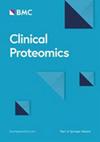The relationship between serum astroglial and neuronal markers and AQP4 and MOG autoantibodies
IF 3.3
3区 医学
Q2 BIOCHEMICAL RESEARCH METHODS
引用次数: 0
Abstract
Certain demyelinating disorders, such as neuromyelitis optica spectrum disorder (NMOSD) and myelin oligodendrocyte glycoprotein antibody-associated disease (MOGAD) exhibit serum autoantibodies against aquaporin-4 (αAQP4) and myelin oligodendrocyte glycoprotein (αMOG). The variability of the autoantibody presentation warrants further research into subtyping each case. To elucidate the relationship between astroglial and neuronal protein concentrations in the peripheral circulation with occurrence of these autoantibodies, 86 serum samples were analyzed using immunoassays. The protein concentration of glial fibrillary acidic protein (GFAP), neurofilament light chain (NFL) and tau protein was measured in 3 groups of subcategories of suspected NMOSD: αAQP4 positive (n = 20), αMOG positive (n = 32) and αMOG/αAQP4 seronegative (n = 34). Kruskal-Wallis analysis, univariate predictor analysis, and multivariate logistic regression with ROC curves were performed. GFAP and NFL concentrations were significantly elevated in the αAQP4 positive group (p = 0.003; p = 0.042, respectively), and tau was elevated in the αMOG/αAQP4 seronegative group (p < 0.001). A logistic regression model to classify serostatus was able to separate αAQP4 seropositivity using GFAP + tau, and αMOG seropositivity using tau. The areas under the ROC curves (AUCs) were 0.77 and 0.72, respectively. Finally, a combined seropositivity versus negative status logistic regression model was generated, with AUC = 0.80. The 3 markers can univariately and multivariately classify with moderate accuracy the samples with seropositivity and seronegativity for αAQP4 and αMOG.血清星形胶质细胞和神经元标记物与 AQP4 和 MOG 自身抗体之间的关系
某些脱髓鞘疾病,如神经脊髓炎视网膜谱系障碍(NMOSD)和髓鞘少突胶质细胞糖蛋白抗体相关疾病(MOGAD),会出现针对水通道蛋白-4(αAQP4)和髓鞘少突胶质细胞糖蛋白(αMOG)的血清自身抗体。由于自身抗体表现的多变性,需要对每个病例的亚型进行进一步研究。为了阐明外周循环中星形胶质细胞和神经元蛋白浓度与这些自身抗体发生率之间的关系,研究人员使用免疫测定法分析了86份血清样本。在 3 组疑似 NMOSD 亚类中测量了胶质纤维酸性蛋白(GFAP)、神经丝蛋白轻链(NFL)和 tau 蛋白的浓度:αAQP4 阳性(n = 20)、αMOG 阳性(n = 32)和 αMOG/αAQP4 血清阴性(n = 34)。研究人员进行了 Kruskal-Wallis 分析、单变量预测分析和带 ROC 曲线的多变量逻辑回归分析。αAQP4阳性组的GFAP和NFL浓度明显升高(分别为p = 0.003和p = 0.042),而αMOG/αAQP4血清阴性组的tau浓度升高(p < 0.001)。通过逻辑回归模型对血清状态进行分类,可以利用 GFAP + tau 将 αAQP4 血清阳性与利用 tau 将 αMOG 血清阳性区分开来。ROC 曲线下面积(AUC)分别为 0.77 和 0.72。最后,生成了血清阳性与阴性状态的组合逻辑回归模型,AUC = 0.80。这三种标记物可以对αAQP4和αMOG血清阳性和血清阴性样本进行单变量和多变量分类,准确度中等。
本文章由计算机程序翻译,如有差异,请以英文原文为准。
求助全文
约1分钟内获得全文
求助全文
来源期刊

Clinical proteomics
BIOCHEMICAL RESEARCH METHODS-
CiteScore
5.80
自引率
2.60%
发文量
37
审稿时长
17 weeks
期刊介绍:
Clinical Proteomics encompasses all aspects of translational proteomics. Special emphasis will be placed on the application of proteomic technology to all aspects of clinical research and molecular medicine. The journal is committed to rapid scientific review and timely publication of submitted manuscripts.
 求助内容:
求助内容: 应助结果提醒方式:
应助结果提醒方式:


